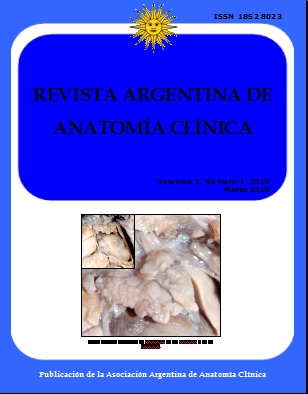ANATOMÍA QUIRÚRGICA DEL COLGAJO OSTEOCUTÁNEO DE PERONÉ Y SU APLICACIÓN EN RECONSTRUCCIÓN MANDIBULAR SURGICAL ANATOMY OF THE FIBULAR OSTEOCUTANEOUS FREE FLAP IN MANDIBULAR RECONSTRUCTION
DOI:
https://doi.org/10.31051/1852.8023.v2.n1.13862Keywords:
cirugía reparadora, resección mandibular, colgajos microquirúrgicos, reconstructive surgery, mandibular resection, free flap.Abstract
Introducción: La reconstrucción mandibular constituye un permanente desafío ya que implica la restauración de múltiples funciones. Se han ensayado diversas técnicas y materiales siendo en la actualidad el colgajo de peroné el estándar de tratamiento reconstructivo. Objetivos: Estudiar las características del colgajo peroné aplicado a la reconstrucción mandibular. Material y método: Entre enero de 2006 y abril de 2009 se realizaron un total de 18 colgajos microquirúrgicos de peroné, siendo el 50% de tipo osteocutáneos. Diez fueron mujeres con una edad promedio de 58 años. Resultados. Encontramos constante la disposición anatómica vascular, tanto la irrigación ósea como de la pastilla cutánea, así también como la anatomía nerviosa y los parámetros musculares para el abordaje del hueso. Hallamos un promedio de 1,7 ramas perforantes septocutáneas. No obtuvimos pedículos vasculares mayores a 8 cm. de longitud. El resultado estético y funcional de nuestras reconstrucciones fue más que aceptable aportando buena cantidad de tejido óseo e incluso en 3 casos fueron colocados implantes osteointegrados. Conclusiones: El colgajo microvascularizado de peroné, en sus diferentes variedades osteo u osteocutáneo, constituye un colgajo seguro, siendo la primera elección en reconstrucción mandibular, debido a sus características anatómicas óseas, a su constante disposición anatómica vascular, y al mínimo déficit que produce en la zona dadora.
Introduction: The mandibular reconstruction is a permanent challenge as the restoration of many functions depends on it. Multiple techniques and materials have been used and, at the present, the fibular free flap is the goal standard reconstructive treatment. Objective: We studied the characteristics of the fibular flap applied to the mandibular reconstruction. Material and method: We performed a total of 18 microsurgical fibula free flap between January 2006 and April 2009; 50% of them were osteocutaneos type. Ten were women and average age was 58 years. Result: Anatomic elements had regular distribution, including the vascular supply, as well the for the bone as for the skin paddle, nervous branches and muscular parameters considered for bone approach. Perforating septo-cutaneous branches were 1.7 average. We could not manage vascular pedicles longer than 8 cm. Stetic and funtional results could be considered better than acceptable, providing good cuantity of bone tissue and including three cases of osseointegrated implants. Conclusions: The fibular free flap is safe, being the first choice in mandibular reconstruction, due to the anatomical bone characteristics, the constant vascular anatomy and the minimal mobility caused to the donor.
Downloads
Published
Issue
Section
License
Authors retain copyright and grant the journal right of first publication with the work simultaneously licensed under a Creative Commons Attribution License that allows others to share the work with an acknowledgement of the work's authorship and initial publication in this journal. Use restricted to non commercial purposes.
Once the manuscript has been accepted for publications, authors will sign a Copyright Transfer Agreement to let the “Asociación Argentina de Anatomía Clínica” (Argentine Association of Clinical Anatomy) to edit, publish and disseminate the contribution.



